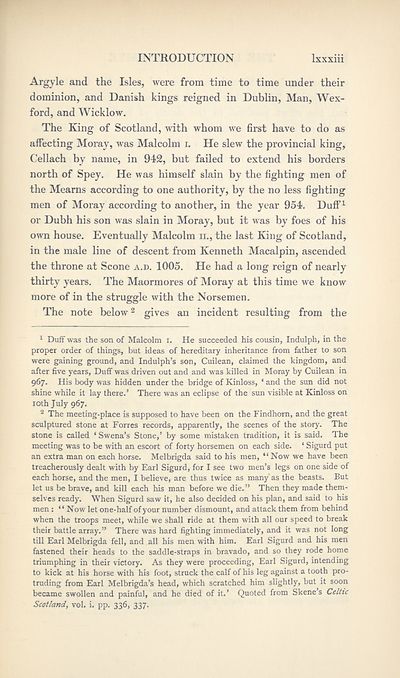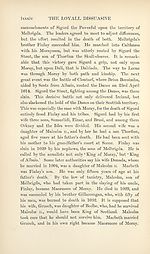Series 1 > Loyall dissuasive
(98) Page lxxxiii
Download files
Complete book:
Individual page:
Thumbnail gallery: Grid view | List view

INTRODUCTION
Ixxxiii
Argyle and the Isles, were from time to time under their
dominion, and Danish kings reigned in Dublin, Man, Wex¬
ford, and Wicklow.
The King of Scotland, with whom we first have to do as
affecting Moray, was Malcolm i. He slew the provincial king,
Cellach by name, in 942, but failed to extend his borders
north of Spey. He was himself slain by the fighting men of
the Mearns according to one authority, by the no less fighting
men of Moray according to another, in the year 954. Duff1
or Dubh his son was slain in Moray, but it was by foes of his
own house. Eventually Malcolm u., the last King of Scotland,
in the male line of descent from Kenneth Macalpin, ascended
the throne at Scone a.d. 1005. He had a long reign of nearly
thirty years. The Maormores of Moray at this time we know
more of in the struggle with the Norsemen.
The note below2 gives an incident resulting from the
1 Duff was the son of Malcolm i. He succeeded his cousin, Indulph, in the
proper order of things, but ideas of hereditary inheritance from father to son
were gaining ground, and Indulph’s son, Cuilean, claimed the kingdom, and
after five years, Duff was driven out and and was killed in Moray by Cuilean in
967. His body was hidden under the bridge of Kinloss, ‘ and the sun did not
shine while it lay there.1 There was an eclipse of the sun visible at Kinloss on
10th July 967.
2 The meeting-place is supposed to have been on the Findhom, and the great
sculptured stone at Forres records, apparently, the scenes of the story. The
stone is called ‘ Swena’s Stone,’ by some mistaken tradition, it is said. The
meeting was to be with an escort of forty horsemen on each side. ‘ Sigurd put
an extra man on each horse. Melbrigda said to his men, “Now we have been
treacherously dealt with by Earl Sigurd, for I see two men’s legs on one side of
each horse, and the men, I believe, are thus twice as many'as the beasts. But
let us be brave, and kill each his man before we die.” Then they made them¬
selves ready. When Sigurd saw it, he also decided on his plan, and said to his
men : “ Now let one-half of your number dismount, and attack them from behind
when the troops meet, while we shall ride at them with all our speed to break
their battle array.” There was hard fighting immediately, and it was not long
till Earl Melbrigda fell, and all his men with him. Earl Sigurd and his men
fastened their heads to the saddle-straps in bravado, and so they rode home
triumphing in their victory. As they were proceeding, Earl Sigurd, intending
to kick at his horse with his foot, struck the calf of his leg against a tooth pro¬
truding from Earl Melbrigda’s head, which scratched him slightly, but it soon
became swollen and painful, and he died of it.’ Quoted from Skene’s Celtic
Scotland, vol. i. pp. 336, 337.
Ixxxiii
Argyle and the Isles, were from time to time under their
dominion, and Danish kings reigned in Dublin, Man, Wex¬
ford, and Wicklow.
The King of Scotland, with whom we first have to do as
affecting Moray, was Malcolm i. He slew the provincial king,
Cellach by name, in 942, but failed to extend his borders
north of Spey. He was himself slain by the fighting men of
the Mearns according to one authority, by the no less fighting
men of Moray according to another, in the year 954. Duff1
or Dubh his son was slain in Moray, but it was by foes of his
own house. Eventually Malcolm u., the last King of Scotland,
in the male line of descent from Kenneth Macalpin, ascended
the throne at Scone a.d. 1005. He had a long reign of nearly
thirty years. The Maormores of Moray at this time we know
more of in the struggle with the Norsemen.
The note below2 gives an incident resulting from the
1 Duff was the son of Malcolm i. He succeeded his cousin, Indulph, in the
proper order of things, but ideas of hereditary inheritance from father to son
were gaining ground, and Indulph’s son, Cuilean, claimed the kingdom, and
after five years, Duff was driven out and and was killed in Moray by Cuilean in
967. His body was hidden under the bridge of Kinloss, ‘ and the sun did not
shine while it lay there.1 There was an eclipse of the sun visible at Kinloss on
10th July 967.
2 The meeting-place is supposed to have been on the Findhom, and the great
sculptured stone at Forres records, apparently, the scenes of the story. The
stone is called ‘ Swena’s Stone,’ by some mistaken tradition, it is said. The
meeting was to be with an escort of forty horsemen on each side. ‘ Sigurd put
an extra man on each horse. Melbrigda said to his men, “Now we have been
treacherously dealt with by Earl Sigurd, for I see two men’s legs on one side of
each horse, and the men, I believe, are thus twice as many'as the beasts. But
let us be brave, and kill each his man before we die.” Then they made them¬
selves ready. When Sigurd saw it, he also decided on his plan, and said to his
men : “ Now let one-half of your number dismount, and attack them from behind
when the troops meet, while we shall ride at them with all our speed to break
their battle array.” There was hard fighting immediately, and it was not long
till Earl Melbrigda fell, and all his men with him. Earl Sigurd and his men
fastened their heads to the saddle-straps in bravado, and so they rode home
triumphing in their victory. As they were proceeding, Earl Sigurd, intending
to kick at his horse with his foot, struck the calf of his leg against a tooth pro¬
truding from Earl Melbrigda’s head, which scratched him slightly, but it soon
became swollen and painful, and he died of it.’ Quoted from Skene’s Celtic
Scotland, vol. i. pp. 336, 337.
Set display mode to:
![]() Universal Viewer |
Universal Viewer | ![]() Mirador |
Large image | Transcription
Mirador |
Large image | Transcription
Images and transcriptions on this page, including medium image downloads, may be used under the Creative Commons Attribution 4.0 International Licence unless otherwise stated. ![]()
| Scottish History Society volumes > Series 1 > Loyall dissuasive > (98) Page lxxxiii |
|---|
| Permanent URL | https://digital.nls.uk/127548181 |
|---|
| Attribution and copyright: |
|
|---|
| Description | Over 180 volumes, published by the Scottish History Society, containing original sources on Scotland's history and people. With a wide range of subjects, the books collectively cover all periods from the 12th to 20th centuries, and reflect changing trends in Scottish history. Sources are accompanied by scholarly interpretation, references and bibliographies. Volumes are usually published annually, and more digitised volumes will be added as they become available. |
|---|


